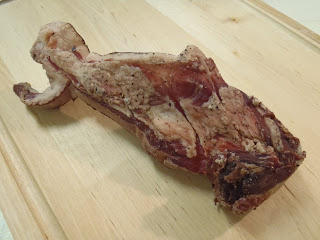By chance, I was cooking four dishes that I have posted about in the past. Descriptions follow. All "Hipstamatic photos" are courtesy of Andy Grabia, a true son of Erin (his aversion to brawn notwithstanding). Thank you, again, Martin Kennedy, for playing host.
Brawn, Clover, Buttermilk
Brawn is the British word for headcheese, the preparation of which I wrote about here. In that post I mentioned that the brawn would look much, much better if the meat were first brined; it would be rosy pink, instead of questionable grey. This time around I did a proper brine of kosher salt, curing salt, and brown sugar.
I cut the jowl and tongue into tidy cubes that were white and red, respectively, while shredding the rest of the head meat. I enjoyed this incarnation of the headcheese much, much more than the last. Unfortunately the dish wasn't received enthusiastically. The modern eater has a serious problem with meat jelly.
 The brawn was garnished with clover shoots. I thought serving clover on St. Paddy's day was a fantastic idea. Besides the obvious Irish connection, it seemed appropriate to serve sprouts at a time of year when we we're sprouting our seedlings indoors, waiting for the snow to melt (see left). Judy bought a bag of red clover from a seed vendor, who was mildly disgusted when she found out we were going to eat the sprouts ("Clover's cow food!"). The shoots are almost indistinguishable from alfalfa. They taste fine on their own, but honestly they didn't add much to the dish.
The brawn was garnished with clover shoots. I thought serving clover on St. Paddy's day was a fantastic idea. Besides the obvious Irish connection, it seemed appropriate to serve sprouts at a time of year when we we're sprouting our seedlings indoors, waiting for the snow to melt (see left). Judy bought a bag of red clover from a seed vendor, who was mildly disgusted when she found out we were going to eat the sprouts ("Clover's cow food!"). The shoots are almost indistinguishable from alfalfa. They taste fine on their own, but honestly they didn't add much to the dish.Sprouting is dead simple. Just soak the seeds in water overnight, then drain and rinse twice a day until they grow to the desired maturity. We kept our seeds in a glass jar with a nylon stocking stretched over the mouth. Water can be poured through the stocking to rinse the sprouts, then the glass can be inverted to drain the water away.



Headcheese is beautiful - visually and conceptually - and it pains me as a professional cook that I will probably never be able to prepare this to an appreciative audience.

The sauce was mayonnaise made with egg yolks and cold-pressed canola, thinned out with buttermilk for a bit of tang, and spiced with cayenne and mustard.


Potato Broth, Dumplings
I first wrote about potato broth here. The basic idea is to steep potato skins in vegetable broth to infuse the liquid with the distinct flavour of potatoes. This particular version didn't work out too well. The broth didn't take the flavour of the skins, possibly because I boiled the potatoes before peeling them, instead of roasting them as I did last time.
Black Pudding, Colcannon, Apples
Black Pudding is the British word for blood sausage, the preparation of which I wrote about here. In that post I mentioned that the filling didn't bind properly: the cooked sausages crumbled when sliced. This time I tried a recipe from the Au Pied de Cochon Cookbook. My only departure from Picard's recipe was using oat flour instead of chestnut flour. The major difference between this recipe and the last is the inclusion of a panada, which is bread soaked in milk. The final sausages held together beautifully, and were tender and smooth to boot. This is now my default blood sausage recipe. Thank you, Martin.
Colcannon is a mix of mashed potatoes and cabbage or kale. My colcannon is mashed potatoes heated in some of the brawn cooking liquid and butter, then mixed with shredded cabbage that has been braised in cider vinegar and bacon fat.
After the black pudding rounds were seared in a skillet, slices of Granny Smith were cooked in the same pan.





Whiskied Fruitcake, Hard Sauce
My computer is trying to tell me that "whisky" isn't a verb. How frustrating. I made fruitcake for the first time this past Christmas, and wrote about it here.
Fruitcake is a very common dish in Great Britain, even outside the Christmas season. This particular manifestation was made with orange peel, walnuts, and raisins. I soaked the baked cake in Jameson's. Though appropriate to the St. Paddy's Day theme, Irish whisky is much less aromatic than rum, and not great for flavouring baked goods.
The cake was dressed with a classic hard sauce: two parts icing sugar cooked out in one part butter, then finished with Jameson's and egg.

Other Notes from the Dinner: Alcohol and Literature
 That's protestant whiskey!
That's protestant whiskey!-McNulty on Bushmills, in The Wire
As you might expect, alcohol played an important part in the dinner. I was thoroughly razzed for bringing Bushmills ("Protestant whiskey"), though it was appropriate to my Orange heritage.
There's a big difference between Scotch and Irish whiskey. The malted barley used in Scotch is dried over peat fires, and after fermenting, is twice distilled. Traditional Irish whiskey doesn't have any of the smoky, peaty notes of Scotch, and is thrice distilled for a smoother taste. Mel Priestley recently wrote a brief but informative article for Vue Weekly on the history of Irish whiskey. Thank you, Mel.
The real star of the show was Redbreast Irish whiskey. Very, very smooth. Heavy on the butterscotch. Delectable.
Obviously there was Guinness.
I can't imagine that Joyce was a willing celebrant of St. Patrick's Day, but he still made an appearance at our dinner.

Now, at the name of the fabulous artificer, he seemed to hear the noise of dim waves and to see a winged form flying above the waves and slowly climbing the air. What did it mean? Was it a quaint device opening a page of some medieval book of prophecies and symbols, a hawklike man flying sunward above the sea, a prophecy of the end he had been born to serve and had been following through the mists of childhood and boyhood, a symbol of the artist forging anew in his workshop out of the sluggish matter of the earth a new soaring impalpable imperishable being?

Welcome, O life! I go to encounter for the millionth time the reality of experience and to forge in the smithy of my soul the uncreated conscience of my race.































